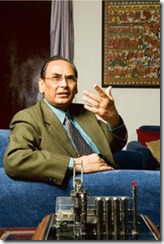By Rupakjyoti Borah
With most of the ULFA leadership either in prison or on the run, the militant outfit is in bad shape – an opportunity for New Delhi and for peace.

ULFA Chairman Rajkhowa arrives at court
The controversial ‘arrest’ of United Liberation Front of Asom (ULFA) Chairman Arabinda Rajkhowa and Deputy Commander-in-Chief Raju Baruah in early December caused a localized storm that nonetheless quickly died down.
Whether Bangladeshi authorities picked up the two leaders and handed them over to Indian authorities, or whether they surrendered in India itself remains shrouded in mystery.
But what is certain is that apprehending such prominent leaders represents a turning point in Assam’s separatist politics. Past attempts at peace have consistently fizzled out, leading the insurgency to rage for more than three decades.
Indeed, much water has flowed down the mighty Brahmaputra since the ULFA was founded on 7 April 1979 at the historic Rang Ghar in upper Assam, an amphitheatre dating back to the Ahoms, the pre-British monarchs who ruled for some six centuries.
In the early 1990s, after successive operations by the Indian Army attempted to root out the outlawed group, the ULFA began to shift its bases to Bhutan.
By 2003, there were about 30 camps inside Bhutan, housing around 3500 militants. In December of that year, however, the Royal Bhutan Army launched Operation All Clear against ULFA as well as cadres with the Kamatapur Liberation Organisation (KLO) and National Democratic Front of Bodoland (NDFB) holed up in the country.
During this action, around 650 militants were either killed or captured. Subsequently, many senior ULFA leaders fled to Bangladesh, again operating from across the border, until Dhaka began a serious crackdown late last year. This has now led to the arrest of eight prominent leaders, including Rajkhowa and Baruah.
Even as this changed context has sparked hopes of peace in Assam, any optimism is tinged with a sense of the numerous past failures in this regard. When on 7 September 2005, for instance, ULFA nominated an 11-member group, christened the People’s Consultative Group (PCG), led by writer Indrani Goswami, to prepare the groundwork for eventual talks with New Delhi, this turn of events likewise raised hopes. Yet while the much-awaited first round of talks between the PCG and the Centre were held soon after, the peace process quickly ran into rough weather.
The ULFA leadership put forth three conditions for the talks: that sovereignty be the core issue; the release of five ULFA Central Committee members; and information on the whereabouts of cadres who had been missing since Operation All Clear. The interlocutors in New Delhi, however, were unwilling to accept any of these. After a yearlong stuttering relationship, the PCG pulled out from the peace process, alleging lack of sincerity on the part of the government. Thereafter, ULFA resumed its armed tactics and army operations resumed.
All the same, the militant outfit suffered a significant setback on 24 June 2008, when the ‘A’ and ‘C’ companies of its 28th Battalion – ULFA’s strongest unit in terms of both military and fundraising prowess – announced a ceasefire. Some 200 cadres, led by five high-ranking commanders, came aboveground and advocated continuing the talks with the government.
But whoever thought that the ULFA epitaph had been written were quickly proved wrong when, four months later, on 30 October, serial blasts rocked Assam, claiming at least 66 lives and injuring over 450. Though ULFA denied involvement, security officials have refused to buy the argument.
Against this backdrop, there are many reasons why New Delhi should take the initiative to resume talks with ULFA in the current context. To begin with, ULFA is arguably farther on its back foot than at any time in the past, with ties between India and Bangladesh showing a notable turnaround after Sheikh Hasina took over the reins last year in Bangladesh.
In a significant step, during Prime Minister Hasina’s official visit to India in January, the two neighbors signed three major agreements dealing with mutual law-and-order concerns, which have surely made life increasingly difficult for ULFA leaders remaining in Bangladesh.
Indeed, matters are already moving forward. In addition to the earlier arrest of Rajkhowa and Baruah, Dhaka has hinted that ULFA General-Secretary Anup Chetia, who was arrested in Bangladesh in 1997, could soon be handed over to Indian officials. Further, on 1 November last year, ULFA Foreign Secretary Sasha Choudhury and Finance Secretary Chitraban Hazarika were also arrested in Bangladesh, and are already in jail in Assam. As such, with most of the senior leaders under arrest, and the group in shambles, New Delhi may well have the upper hand if negotiations ensue.
At the same time, even as Thimphu and Dhaka appear to be cooperating fully with New Delhi, it is important to keep ULFA’s ties with Burma in mind. Indeed, reports are currently circulating that the group’s military chief, Paresh Baruah, is hiding in Burma.
This may not be particularly problematic for New Delhi, however, considering its close ties with the junta, and the latter’s brutal treatment of its own homegrown insurgencies.
Indeed, Naypyidaw and New Delhi even staged a joint operation, codenamed Operation Golden Bird, in 1995 to hunt down ULFA operatives hiding in Burma. There is no reason to believe the junta would shy away from a similar exercise now, should New Delhi be keen on the idea.
Gateway
With New Delhi in such a strong position, analysis must now be pointed to the future. Much would be gained from talks between government officials and the ULFA leadership.
If these were to succeed, the state and the central governments could finally devote their energies to addressing the pressing concerns of the people – unemployment and illegal migration from Bangladesh, and offering a concerted effort to deal with the devastating annual floods.
Meanwhile, tourism could prove to be a big earner for the state and its populace if potential visitors can be assured of their safety. On a larger level, peace in Assam would have a positive spill-over effect into the other parts of the Northeast, where many of the states are also reeling under violence.
The National Socialist Council of Nagaland (Isak-Muivah), for instance, has operated under a ceasefire with New Delhi since 1997, while its leaders, Thuingaleng Muivah and Isak Chisi Swu, recently held more talks with Home Minister P Chidambaram. If ULFA follows a similar track, there would be pressure on the other insurgent groups in the area to do likewise.
A period of peace could also help to turn Assam and the Northeast into a gateway to Southeast Asia. Under its Look East policy, New Delhi has for years been trying to figure out how to develop closer ties with the economies of Southeast and East Asia, even mooting a highway project involving Burma and Thailand and a rail link between New Delhi and Hanoi. The possibility of the re-opening of the historic Stilwell Road, which runs from Ledo in Assam to Kunming in China via Burma, is also being discussed. Assam and the entire Northeast have much to gain from better ties with the Southeast Asian countries.
In late February, Tarun Gogoi, the chief minister of Assam, stated that his government was indeed willing to talk to the rebels, but on the condition that the issue of sovereignty is taken off the table. To back its rhetoric, and pave the way for peace talks, the state government also did not oppose the bail appeal of two senior ULFA leaders in custody, Pradip Gogoi and Mithinga Daimary.
In the current context, the only hold-up appears to be the Dispur government’s insistence on bringing in ULFA Commander-in-Chief Paresh Baruah, as no peace deal is likely to last without his nod.
Rupakjyoti Borah is a doctoral student at the School of International Studies, Jawaharlal Nehru University, New Delhi.
 New Delhi, Apr 1 : Union Government's interlocutor for Naga peace talks R. S. Pandey on Wednesday asked the media to report more on progress and development of the northeast region than just covering problems.
New Delhi, Apr 1 : Union Government's interlocutor for Naga peace talks R. S. Pandey on Wednesday asked the media to report more on progress and development of the northeast region than just covering problems.












